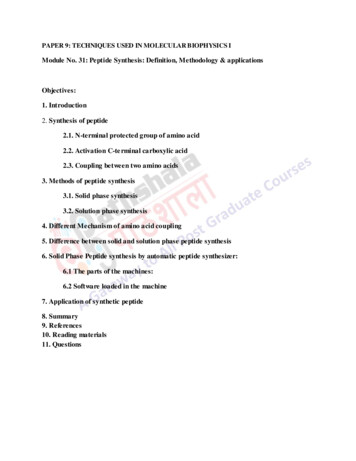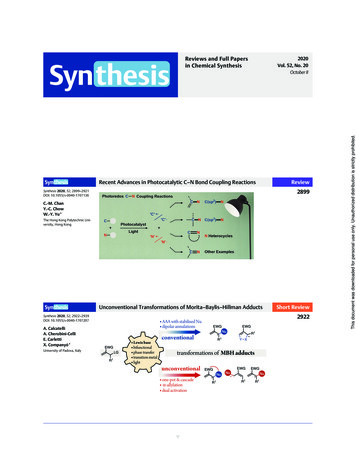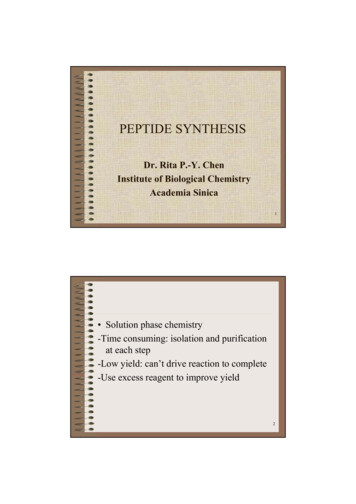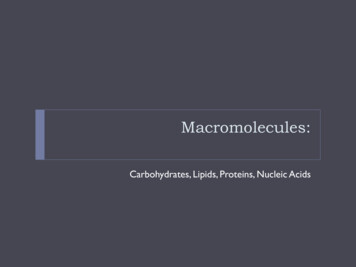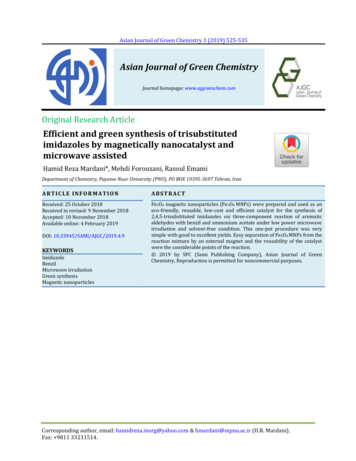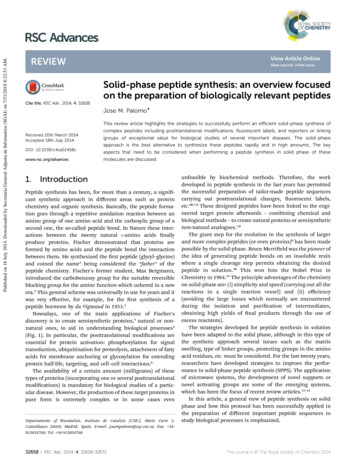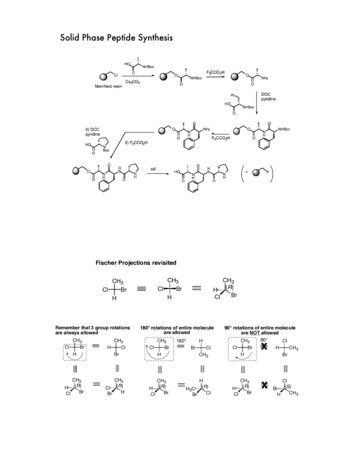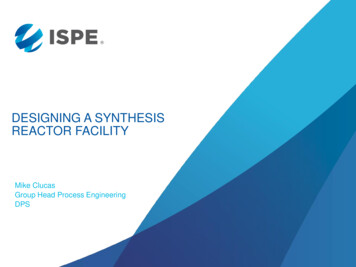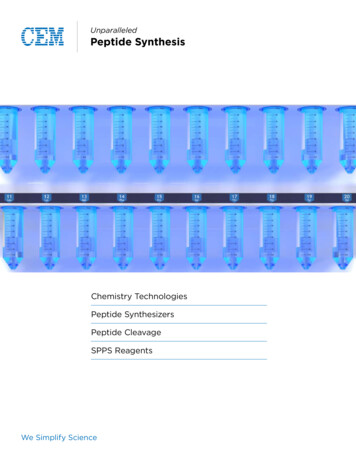
Transcription
Articlepubs.acs.org/cmCite This: Chem. Mater. XXXX, XXX, XXX-XXXMaterials Synthesis Insights from Scientific Literature via TextExtraction and Machine LearningEdward Kim,† Kevin Huang,† Adam Saunders,‡ Andrew McCallum,‡ Gerbrand Ceder,§and Elsa Olivetti*,††Department of Materials Science and Engineering, Massachusetts Institute of Technology, Cambridge, Massachusetts 02139, UnitedStates‡Computer Science Department, University of Massachusetts Amherst, Amherst, Massachusetts 01003, United States§Materials Science and Engineering, University of California Berkeley, Berkeley, California 94720, United StatesS Supporting Information*ABSTRACT: In the past several years, Materials GenomeInitiative (MGI) efforts have produced myriad examples ofcomputationally designed materials in the fields of energystorage, catalysis, thermoelectrics, and hydrogen storage as wellas large data resources that are used to screen for potentiallytransformative compounds. The bottleneck in high-throughputmaterials design has thus shifted to materials synthesis, whichmotivates our development of a methodology to automaticallycompile materials synthesis parameters across tens ofthousands of scholarly publications using natural languageprocessing techniques. To demonstrate our framework’scapabilities, we examine the synthesis conditions for variousmetal oxides across more than 12 thousand manuscripts. Wethen apply machine learning methods to predict the critical parameters needed to synthesize titania nanotubes via hydrothermalmethods and verify this result against known mechanisms. Finally, we demonstrate the capacity for transfer learning by usingmachine learning models to predict synthesis outcomes on materials systems not included in the training set and therebyoutperform heuristic strategies. INTRODUCTIONFirst-principles materials design, open access materials propertydatabases,1 3 and machine learning4,5 have accelerated novelcompound identification for a variety of applications, includingenergy storage, catalysis, thermoelectrics, and hydrogenstorage.6 14 To fully realize the vision of the Materials GenomeInitiative of accelerating materials development,15 18 we must,in a comprehensive and accessible way, link the compositions,structures, and morphologies of these computationallydiscovered materials to the synthesis conditions that canproduce them. This work represents a small step in thedirection toward this goal of systematically understanding therelationships between synthesized materials and reactionconditions by broadly data mining the literature.The materials design community remains gated by the use ofheuristic synthesis guidelines once a particular material ofinterest has been identified, either by direct first-principlescomputations or screening methods.6,19,20 As a result, thesynthesis of targeted novel compounds is rapidly becoming theslow step in computationally driven materials design. Withdirect modeling of the complex kinetic processes occurringduring synthesis out of reach, a data-driven, machine learningapproach that learns from the hundreds of thousands of XXXX American Chemical Societypublished synthesis recipes may be more productive. As a steptoward this objective, we use recent advances in full-textpublisher application programming interfaces (APIs)21 andnatural language processing (NLP)22 26 to develop a statisticallearning approach to materials synthesis. While numerousstudies have focused on text extraction from scientificliterature,22 24,27 29 we present here a framework focused onthe problem of extracting and data-mining materials synthesisconditions.Using a variety of machine learning and natural languageprocessing techniques, our platform automatically retrievesarticles and then extracts and codifies the materials synthesisconditions and parameters found in the text. By combiningthese text-mined synthesis parameters at large scale, thissynthesis database can be mined to discover the underlyingrelationships between synthesis conditions and the materialsthey produce. This literature-based data mining strategy alsocomplements and benefits from current combinatorial and insitu synthesis studies which produce libraries of materials withReceived: August 21, 2017Revised: October 8, 2017ADOI: 10.1021/acs.chemmater.7b03500Chem. Mater. XXXX, XXX, XXX XXX
ArticleChemistry of MaterialsThe parse tree for each sentence is then scanned again for nounphrases (e.g., LiOH, ethanol, gold NPs, powder), and these phrases arematched against the PubChem database,38 a character n-gram classifier(which achieves 82% accuracy for identifying materials), and thepretrained ChemDataExtractor model24 to validate whether or notthey are references to meaningful materials. These matches, along withword embedding vectors37 trained on our corpus of papers, are fedinto a neural network which predicts word categories (i.e., material,operation, amount, or condition). Training this neural network with 5000 human annotated words yields an overall accuracy of 86% forword categories, as measured against a set of approximately 100human-annotated synthesis articles.35Some of the errors made by the text extraction algorithms arecorrected systematically by considering technological and practicallimitations. As an example, the “degree” symbol is sometimes decodedfrom PDF documents as a numerical digit, which can adversely affecttemperature parsing; this issue is fixed by pattern searches whentemperatures are parsed above or below reasonable limits for relatedsynthesis steps.The authors note that the parsing and text extraction techniquespresented here focus solely on information written in the main bodytext of scientific journal articles (and specifically the title, abstract, andmethods sections). As a contrasting example, Swain et al. designed asystem for data extraction from tables,24 and the authors intend forfuture work to make use of both plain-text and tabular synthesis data,as such approaches would be informative for linking synthesis methodswith resulting materials properties. Furthermore, text extraction fromelsewhere within a manuscript, such as the results section, wouldprovide information on the quality of the resulting material.Verification of Annotated Data. In addition to the set ofannotated data used to measure predictive accuracies for textextraction, another set of 30 articles was annotated in duplicate,independently, by two materials science researchers. These encodedarticles were used to both confirm the consistency of the annotationprocedure and provide a baseline for the upper-bounds of expectedperformance from any machine learning algorithms, by comparing thelevel of human agreement between the encoded articles. Inspection ofthese articles postannotation confirmed that annotation differencesstemmed from details irrelevant to key synthesis details (e.g.,annotating an intermediate material as a solution versus a samplewas a common difference).Data Mining and Machine Learning. Extracted synthesisparameters are encoded and compiled into a monolithic database,which can then be programmatically queried. We use this database toquantitatively analyze synthesis steps such as hydrothermal andcalcination reactions reported in the literature. Additionally, thedatabase is used to train machine learning models by providingexamples of synthesis parameters and synthesis outcomes.We note that our machine learning models do not yet robustlyhandle the separation of multiple synthesis routes described in a singlepaper, as it is nontrivial to detect natural language boundaries betweensynthesis routes. Therefore, we focus our data mining on specificreaction steps rather than entire synthesis routes to avoid conflatingthe end of one synthesis route with the beginning of another.All machine learning models are implemented with scikit-learn andtensorf low.36,39 The details of all machine learning model parametersare provided in the Supporting Information. The machine learningsetup in Figure 2, involving a decision tree along with a linear classifier,was motivated by similar models used by Raccuglia et al. which werefound to produce state-of-the-art results on their data. Raccuglia et al.also motivated the use of the machine learning approach shown inFigure 3.33varied compositions to explore a materials parameterspace.30 32Here, we present a platform that leverages the large body ofpublished synthesis recipes through natural language processingand uses these recipes to train machine learning models that aidin developing insights into the key parameters that drive thesynthesis of specific, technologically relevant materials at a highlevel of automation.12,33,34 METHODSThe methods used for text extraction are briefly discussed in thefollowing sections, and these methods are based on the techniquesused by Kim et al.35Article Retrieval. To construct a corpus of journal articles, theCrossRef Application Programming Interface (API)21 is used toprogrammatically retrieve large lists of Digital Object Identifiers(DOIs), which serve as unique article identifiers, related to chosensearch queries (e.g., “battery electrode synthesis”). Following this,a number of publisher APIs are used to download full-text journalarticles, using a click-through service provided by CrossRef. Weretrieve articles in both Portable Document Format (PDF) and plaintext format, depending on availability.Plain-Text Conversion and Classification. Using PDF textprocessing tools (located at https://github.com/iesl/watr-works), weconvert the collected PDF files to plain text files. The body-textcontained within the articles is fed into a paragraph relevance classifier,both to reduce the data volume in later stages of data processing andto differentiate between similar sections of text, such as theexperimental synthesis and materials characterization subsections.To determine which paragraphs contain materials synthesisinformation, we manually applied binary labels to several hundredparagraphs from approximately 100 different journal articles, withpositive samples representing materials synthesis paragraphs andnegative samples representing all other paragraphs. We then use alogistic regression classifier to classify relevant articles, as implementedin the scikit-learn Python module.36To reframe our journal article paragraphs as mathematical objects, a“word embedding” approach is used to transform the paragraphs intoreal-valued vectors, where each paragraph is represented by an averageof context-sensitive word vectors.25,37 This word-embedding approachhas become standard in machine learning literature and was found toyield good performance on materials science vocabularies.35The logistic regression classifier then applies binary labels to theparagraphs, with a label of 1 indicating a synthesis paragraph and 0representing a paragraph unrelated to synthesis. Because there aremany fewer synthesis paragraphs than nonsynthesis paragraphs, we usea class-weighting scheme to assign proportionally greater loss to therarer category during the automated training of the algorithm. Thislogistic regression achieves an overall accuracy of 95% on unseen testdata.Parsing and Extraction. After identification of relevant synthesisparagraphs, the paragraphs are transformed into dependency parsetrees using the ChemDataExtractor and SpaCy parsers.24,25 As a part ofthe parsing process, word tokenization and part-of-speech tagging areperformed. The former refers to splitting each sentence into a list of itsconstituent words (or tokens), and the latter is the process of applyinggrammatical labels to each word token, such as noun or verb. It isoften the case that the synthesis verb of interest (which isautomatically detected by a neural network) is placed at the root ofthe tree,35 with the relevant synthesis parameters and materialsappearing as children within the subtree of the root node.Extraction of synthesis parameters is handled by a mixture of neuralnetwork word labeling and traversal of the dependency parse tree.35The parse tree of each sentence in a synthesis paragraph is scanned forthe presence of key synthesis verbs (e.g., sinter, dissolve, mill), and thedependency parse trees are then iteratively traversed to find operatingparameters (e.g., sintering temperature, stirring speed) by matching tospecific character patterns. RESULTSFrom a collection of over half a million journal articles in ourdatabase, we first apply topic and material-level text queries toselect a set of articles in which metal oxides are synthesized. Asan example of basic information that can be retrieved andexamined in an exploratory manner, we present in Figure 1a theBDOI: 10.1021/acs.chemmater.7b03500Chem. Mater. XXXX, XXX, XXX XXX
ArticleChemistry of MaterialsFigure 1. Synthesis parameter distributions across metal oxide systems. (a) Violin-histogram Gaussian kernel density estimate distributions ofcalcination temperatures for various oxides. Blue and red histogram areas are normalized to reflect relative counts between Bulk and Nano sections.The lists above each violin denote top-five occurring material systems in those temperature ranges. A few select material systems are included as solidand dashed curves within the violins. Each solid and dashed curve has been rescaled to emphasize differences in temperature peaks and relativecounts of Bulk and Nano. (b) 2D hexagonally binned normalized histograms of hydrothermal reaction and calcination times and temperatures forbinary and pentanary oxides. Number of papers is indicated in parentheses after each method label in the legend.distribution of calcination temperatures used in 12 913syntheses recipes of metal oxides, grouped by their numberof constituent elements and whether or not the targets arenanostructured.In each category we list the top 5 materials, by occurrence,and we delineate arbitrary temperature windows 0 700 and700 1100 C to make the peaks easier to see. We also showexample curves for specific materials (with a solid or dashedline) within each distribution, and additional curves areprovided in Supporting Information Figure S2. Each pair ofnanostructured versus bulk distributions is scaled by papercount.Several interesting observations can already be made fromthese plots. High calcination temperatures are found morefrequently in the synthesis of bulk materials with greaterelemental complexity. The difference in calcination temperatureis particularly pronounced between the binaries and highercomponent systems. Indeed, a binary oxide is often formed bystraightforward substitution of the carbonate, hydroxyl, orsimilar anion group in the precursor by oxygen. In contrast, thephase-pure synthesis of multicomponent systems additionallyCDOI: 10.1021/acs.chemmater.7b03500Chem. Mater. XXXX, XXX, XXX XXX
ArticleChemistry of MaterialsFigure 2. Autonomously learned decision boundaries for titania nanotubes. (a) Overview of decision tree model trained and tested on a total of22 065 journal articles. Rounded boxes represent decision points in the tree with univariate normalized histograms plotted alongside the decisionnodes. The dots represent further levels of the decision tree extending downward, which are included in the Supporting Information. (b)Probabilistic machine-learned decision space overlaid in the parameter-space of hydrothermal temperature and NaOH concentration. Circled datapoints denote testing points used to compute classification accuracy, and all other points are training points used to learn the decision space. Thegreen gradient in the background denotes machine-learned probabilistic estimates for nanotube formation with darker green corresponding to higherlikelihoods. Additionally, an experimentally determined plot of a boundary between hydrothermally produced crystalline titania and amorphouslayered sodium titanates is adapted from Tomiha et al.44requires the interdiffusion of multiple metals from theprecursors, necessitating higher temperature. The increase incalcination temperature with number of components is clearestfor the nanoexamples, where the temperature is kept as low aspossible to prevent crystal growth, but mixing of multiplecomponents demands a higher temperature.Because each of the additive distributions in Figure 1arepresents a compilation of many oxides, we comment on someof the key differences among select materials to provide a briefexplanation for the location of each peak. Binary oxides, forinstance, tend to have calcination temperatures between around450 and 550 C. Some of these materials, however, arepredominantly synthesized in nanostructured forms, whileothers are not. For example, we see that alumina (solid line inthe binary violin-histogram) has greater representation to theleft side of the violin (bulk), while zinc oxide (dashed line) hasgreater representation to the right side (nano), consistent withthe ample use of nanoarchitectures for zinc oxide inapplications such as sensors, optoelectronics, and biomedicaldevices.40For the ternary systems shown in Figure 1a, we see a morevaried set of histograms. We contrast barium titanate (solidline) with bismuth ferrite (dashed line). In the ferrite system,the calcination step stabilizes a rhombohedrally distortedperovskite phase within a relatively narrow temperature rangebecause of the tendency to form impurities such as Bi2Fe4O9 athigher temperatures.41 This results in a peak at 750 C forbulk materials, whereas particle size control demands lowertemperature calcination closer to 600 C for nanobismuthferrite. Barium titanate, on the other hand, has a higher andbroader calcination temperature range. The synthesis of thismaterial occurs primarily by solid state reaction whereprecursors of barium carbonate, titania, and others are calcinedbetween 900 and 1100 C.42 We compare this to thequaternary lead zirconate titanate (solid line), which must becalcined at temperatures lower than that for BaTiO3 to preventloss of lead.Finally, we see distinct bimodal distributions for themulticomponent transition-metal oxides used in batteries,LiMnNi- and LiMnNiCo-oxides, shown in the quaternary andpentanary violins, respectively. The solid state synthesisDDOI: 10.1021/acs.chemmater.7b03500Chem. Mater. XXXX, XXX, XXX XXX
ArticleChemistry of Materialsfurther analysis based on the construction of the learneddecision tree rules (in Figure 2b). We chose exactly twofeatures for further analysis to facilitate a visualizable and easilyinterpretable two-dimensional diagram.However, this does come at the necessary cost of someclassification accuracy, which can be observed by comparing theaccuracies of the full decision tree (82%) and the 2D logisticregression classifier (76%). Although these classificationaccuracies are not perfect, they are indeed sufficient for themachine learning models to learn an overall correlationbetween synthesis conditions and the resultant productmorphologies.Figure 2b plots a machine-learned phase diagram in thissynthesis parameter-space, using the axes determined by thedecision tree. In contrast to diagrams which may plot moredirect chemical axes (e.g., free energies, ion activities), weinstead restrict our diagram to experimentally accessible (andexperimentally reported) axes to facilitate practical synthesisroute planning. We note that this reduced 2D parameter spacenow considers only a particular set of syntheses which reporthydrothermal temperatures and NaOH concentrations, and soFigure 2b does not reflect other viable ways of producing titaniananotubes, such as anodization.45 Recipes using higher NaOHconcentrations and lower hydrothermal temperatures, and thusfalling in the darker green area, are more likely to producetitania nanotubes, and indeed these darker green regionscontain a higher density of nanotube-producing (blue) datapoints.This decision rule agrees with the currently acceptedmechanism of titania nanotube formation: titania, with theaddition of sodium ions, transforms into disordered, layeredsodium titanate, and subsequent ion exchange (e.g., via acidwashing) induces a rolling effect on the layers, producing titaniananotubes. Accordingly, it is reasonable to expect that aminimum concentration of sodium ions is required to inducesodium titanate (and subsequently nanotube) formation.44,46 50 Bavykin et al. report that increasing the hydrothermal temperature changes the final product from nanotubesto solid (i.e., nonhollow) fibrous structures, which again agreeswith our learned decision boundary.51 The synthesis conditionaxes learned automatically by the decision tree also agree withliterature findings: the subplot in Figure 2b, reproduced fromTomiha et al.,44 shows a similar trend for the hydrothermalsynthesis of amorphous sodium titanates. By comparison, ourmachine-learned diagram contains many more data pointsaggregated across a range of experimental studies andadditionally extends the span of the data points along thetemperature axis.Figure 2b reveals a link between two related topics inexperimental materials science. Our phase diagram isconstructed entirely from titania synthesis journal articles,many of which directly produce titania nanotubes. Tomiha etal.’s phase diagram in the subplot of Figure 2b is adapted from astudy which only discusses the synthesis of various alkalititanates. It makes no mention of nanotube-like morphologies.44 This type of data-driven analysis can therefore also beused to guide literature review by highlighting correlations andpatterns which are only made apparent when many journalarticles are examined simultaneously.Finally, we show the potential for transfer learning byproducing synthesis outcome predictions across diversematerials systems using this text-mined synthesis data set.While the previous example focused on hydrothermal reactions,approach to making these oxides involves calcination at 800 900 C to crystallize a new phase. Sol gel and coprecipitationsynthesis methods, however, also involve calcination between400 and 500 C to decompose organic constituents or todecompose the carbonate into an oxide.43Beyond our analysis of the calcination temperatures used inthe synthesis of various oxides, we also investigate calcinationtimes and conditions for hydrothermal reactions. Mosthydrothermal reactions, for instance, are carried out between150 and 200 C for 12 or 24 h. Such reactions are conductedabove room temperature and in the presence of autogenouspressure to increase the solubility and reactivity of theprecursors. An upper bound to practically employed reactiontemperatures exists, however, due to the critical points of thesolvents typically used for such reactions (e.g., water, ethanol).Accordingly, as illustrated in Figure 1b, the hydrothermalreactions used to synthesize both simple and complex oxidesoccur at similar and only modestly high temperatures but oftenwith fairly long times.The calcination temperature (occurring at much highertemperatures and shorter times) is typically material-specificand driven by the structural change being sought. For example,binary oxides, largely representing titania, alumina, and zincoxide, are most often calcined at 400 500 C for fewer than 5h. This observed behavior is dominated by TiO2, given the highfrequency with which its synthesis is reported. Calcination isused, in this particular case, to obtain larger grained anatasephase product. More complex oxides must be crystallized atsignificantly higher temperatures (800 900 C) and often formore than 5 h for the diffusion reasons explained previously.To reveal further relations in our database, we use featureselection and classification techniques to identify the key factorsthat drive synthesis outcomes as well as highly probable valuesfor these reaction parameters. Each synthesis route extractedfrom a journal article is composed of many attributes andparameters, including the temperatures and times of heatingoperations, the precursors used, and aspects of themorphologies of the synthesized products. One approach tofeature selection is to inspect the probabilistic model learned bya decision tree and automatically select a strongly predictivereduced subset of synthesis parameters which drive thebehavior of the model.33 By training a decision tree across22 065 journal articles, a hierarchy of single-variable divisionsfor titania nanotube formation is selected from a pool of 27synthesis variables (e.g., annealing temperature, drying time).Figure 2a shows an excerpt of the learned decision tree with thenodes nearest to the root node representing the foremost ruleslearned by the model for maximally separating nanotube andnot-nanotube results. The root node in the decision tree splitsthe data set by NaOH concentration, and the distributions ofthe data projected onto this univariate axis confirm that themajority of recipes use NaOH at concentrations of either 1 or10 M. Hydrothermal temperature is also learned as a drivingfactor for nanotube synthesis, and examination of thetemperature distributions shows some difference between twopeaks at 150 and 180 C, although there is a significant amountof overlap.Examination of the annealing time, on the other hand, clearlyshows that the two distributions are not easily separated,suggesting that this lone feature is not as strongly predictivewhen compared to NaOH concentration or hydrothermaltemperature. For this reason, NaOH concentration andhydrothermal temperature are selected as the variables forEDOI: 10.1021/acs.chemmater.7b03500Chem. Mater. XXXX, XXX, XXX XXX
ArticleChemistry of MaterialsFigure 3. Machine-learned classifiers and predictions across materials systems. (a) Receiver operating characteristic (ROC) curves for tetragonalphase prediction in BaTiO3 on training data. In all four subplots, the three models shown are a Gaussian-kernel support vector machine (SVM)using 20 features (solid red line), a simplified linear heuristic classifier (dotted red line), and a random guessing strategy (black dashed line). Curvescloser to the upper-left corner of the diagram represent more accurate classifiers, with the point exactly on the upper-left corner denoting a perfectclassifier. (b) ROC curves for tetragonal phase prediction in BiFeO3 on unseen test data. (c) ROC curves for 2D morphology prediction in ZnS ontraining data. (d) ROC curves for 2D morphology prediction in CdS on unseen test data.or, equivalently, by comparing the areas under the curves(AUC).Figures 3a and b show tetragonal phase prediction in BaTiO3and BiFeO3. Figure 3a shows how well the classifiers canreproduce the BaTiO3 data on which it is trained. Figure 3bthen shows the prediction quality of that classifier in anothersystem of BiFeO3. The linear heuristic assumes that tetragonalphase formation can be predicted from synthesis temperatures,52,53 and so we use a linear classifier which considers onlysynthesis temperatures as a representative intuition-based rule.While this heuristic strategy outperforms random guessing attraining time in BaTiO3, it has no predictive capability on theunseen test data in BiFeO3. Applying a more complete set ofgeneral synthesis features, including reaction times, solventchoices, and pH modifiers, while also using a nonlinear SVM tobetter capture complicated interactions between synthesisparameters yields a far superior result in terms of classificationaccuracy and consistency between training data and unseen testdata. Note that because the classifier is trained only on BaTiO3,it cannot capture the dependence in choice of synthesisparameters on chemistry, and hence, one would not expect it togive highly accurate results. The fact that there is clearly somepredictive capability of this classifier in BaFeO3 indicates thatthere may be some intrinsic aspects of the synthesis conditionsthat lead to tetragonal phase formation. Hence, more accurateclassification results can be expected when training is performedover larger, chemically diverse sets.In Figures 3c and d, the same comparison between robustnonlinear machine learning and an intuitive heuristic is shownfor ZnS training data and CdS unseen test data, where the goalis to predict synthesized 2D morphologies. Two-dimensionalmaterials synthesis is a rapidly developing field where newchemistries are frequently discovered and broadly applicablehere we examine a set of syntheses which span across a fewadditional synthesis methods (e.g., hydrothermal, sol gel, andsolid state). We predict tetragonal phase formation (versus allother reported phases) in BaTiO3 and in BiFeO3, which isimportant because the ferroelectric properties of these materialsare deeply linked to polarizations and consequently to thesymmetry of the phases.52,53 Additionally, 2D-like morphology(e.g., nanosheet) predictions are performed on ZnS and CdS(vs non-2D morphologies), as such morphologies haveapplications in areas ranging from catalysis to data storage.54Two-dimensional materials also allow for further tuning of keyproperties: as an example, confinement effects play a significantrole in two-dimensional materials and alter the electronicenvironment such that band gaps may differ significantlybetween 3D and 2D morphologies.55,56In each case, we seek a binary classifier which separates thedesirable outcome (e.g., symmetry equals tetragonal, ormorphology equals 2D) from the other outcomes (e.g., not2D). In each subplot of Figure 3, the receiver operatingcharacteristic (ROC) curves are shown for three differentbinary classifiers: a nonlinear Gaussian kernel support vectormachine (SVM), a linear heuristic classifier, and a randomguessing classifier. Each point on these curves represents theperformance of a classifier at a particular decision threshold andthe corresponding true and false positive rates. The curves aregenerated by continuously sweeping through decision thresholdvalues from maximally conservative (never predicting positive)in the lower left corner, to minimally conservative (alwayspredicting positive) in the upper right corner. The upper leftcorner of these
All machine learning models are implemented with scikit-learn and tensorflow.36,39 The details of all machine learning model parameters are provided in the Supporting Information. The machine learning setup in Figure 2, involving a decision tree along with a linear classifier, was motivated by similar models used by Raccuglia et al. which were
